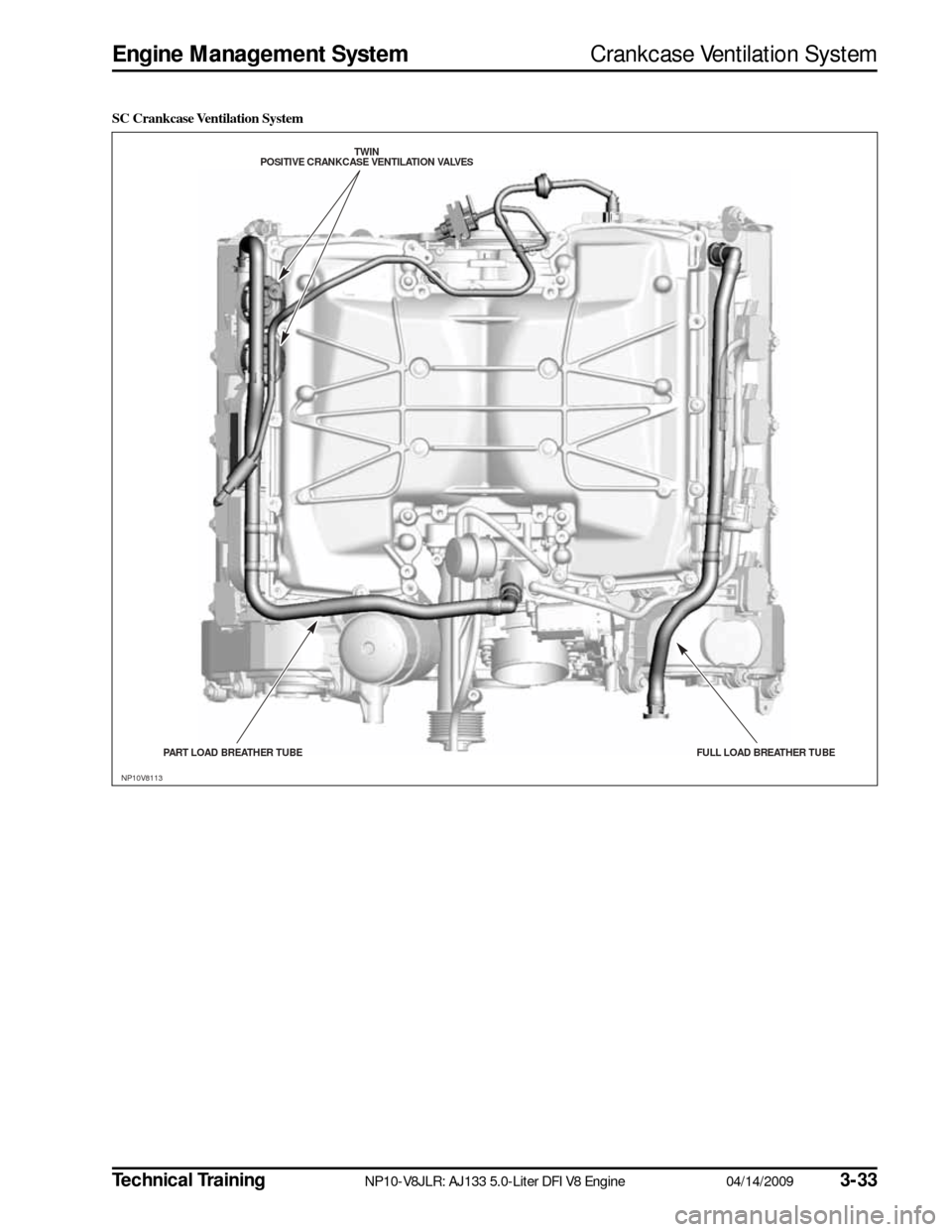engine JAGUAR XF 2009 1.G AJ133 5.0L Engine Manual
[x] Cancel search | Manufacturer: JAGUAR, Model Year: 2009, Model line: XF, Model: JAGUAR XF 2009 1.GPages: 36, PDF Size: 0.38 MB
Page 32 of 36

3-3004/14/2009NP10-V8JLR: AJ133 5.0-Liter DFI V8 EngineTechnical Training
Controller Area Network Engine Management System
CONTROLLER AREA NETWORK
The Controller Area Network (CAN) is a high-speed
serial interface for sharing dynamic signals between elec-
tronic control modules. CAN communications are ‘self-
checked’ for errors, and if an error is detected the message
is ignored by the receiving electronic control module.
Due to the high rate of information exchange, the system
has a high degree of latency. This allows for a high num-
ber of errors to be present without reducing the data
transfer rate. In practice, this is a very reliable system.
Each CAN message is transmitted by one electronic con-
trol module and received by all other electronic control
modules on the CAN bus. Each message contains a fixed
structure of signals. The data exchanged is used so that
each electronic control module does not need to have a
hardwired sensor for each input. The CAN message iden-
tifiers are arranged by a network tool, which can guarantee
that all messages meet their specified timing needs.
Signal Overview
The CAN communication system is a differential bus
using a twisted pair that is normally very reliable. If either
or both of the wires of the twisted pair CAN bus is open-
or short-circuited, a CAN time-out fault will occur.
Below is a list of additional electronic control modules that
the ECM will communicate with on the CAN network:
• Instrument cluster
• Steering angle sensor
•TCM
• Active rear locking differential, if equipped
• Adaptive cruise control
• Electronic parking brake
Failure Modes
• CAN bus wiring short circuit or open circuit
• Incompatible software and message versions
Page 33 of 36

Technical TrainingNP10-V8JLR: AJ133 5.0-Liter DFI V8 Engine04/14/20093-31
Engine Management SystemOn-Board Diagnostic Monitoring
ON-BOARD DIAGNOSTIC MONITORING
Some OBD monitors are continuous, that is they operate
all the time the ignition is on.
Some OBD monitors have conditions that must be met
before the monitor is allowed to operate, such as engine
speed 1000 – 4000 rpm and engine airflow 10 – 100 g/
sec and intake air temperature -10 – +50°C, in order to
ensure the vehicle is operating in such a manner that the
failure may be correctly diagnosed. For this reason it
may be possible for a failure to be present on the vehicle
but remain undetected by the module.
Most OBD monitors use 2-trip detection: if on the first
occasion the failure is detected, a pending DTC is
recorded. If the failure is again detected on the next drive
cycle, then a confirmed DTC is logged and the MIL may
be illuminated.
A few OBD monitors operate on a single-trip basis
where the MIL is illuminated as soon as the failure is
diagnosed.
Detection of a failure may prevent the operation of other
OBD monitors. This is to prevent the logging of multiple
DTCs for a single. However, the system is not infallible,
and a single fault may result in two or more failures
being detected, with two or more DTCs being recorded.
Page 34 of 36

3-3204/14/2009NP10-V8JLR: AJ133 5.0-Liter DFI V8 EngineTechnical Training
Crankcase Ventilation System Engine Management System
CRANKCASE VENTILATION SYSTEM
During a normal compression stroke, small amounts of
gases in the combustion chamber escape past the piston.
Approximately 70% of these gases are unburned fuel
(Hydrocarbons).
The purpose of a Positive Crankcase Ventilation (PCV)
system is to prevent crankcase pressure build-up, protect
engine seals, and remove harmful gases from the crank-
case and combine them with the engine’s normal incom-
ing air/fuel charge. The crankcase is ventilated through part-load and full-
load breathers and oil separators, which consist of a vari-
able geometry oil separator, pressure control valves, and
oil drain valve. This sophisticated system reduces oil
pullover by over half.
The integrated twin PCV valves prevent the hose from
icing and improve driveability in cold climates. The full
load breather hose purges the crankcase and reduces
condensation when the engine is cold.
NA Crankcase Ventilation System
TWIN
POS ITIVE CRANKCAS E VENTILATION VALVES
PART LOAD BREATHER TUBE FULL LOAD BREATHER TUBE
NP10V8112
Page 35 of 36

Technical TrainingNP10-V8JLR: AJ133 5.0-Liter DFI V8 Engine04/14/20093-33
Engine Management SystemCrankcase Ventilation System
SC Crankcase Ventilation System
TWIN
POS ITIVE CRANKCAS E VENTILATION VALVES
PART LOAD BREATHER TUBE FULL LOAD BREATHER TUBE
NP10V8113
Page 36 of 36

3-3404/14/2009NP10-V8JLR: AJ133 5.0-Liter DFI V8 EngineTechnical Training
THIS PAGE LEFT BLANK INTENTIONALLY.